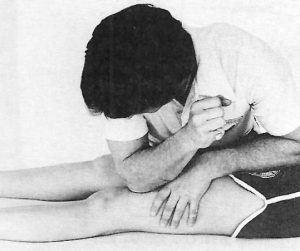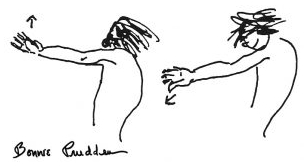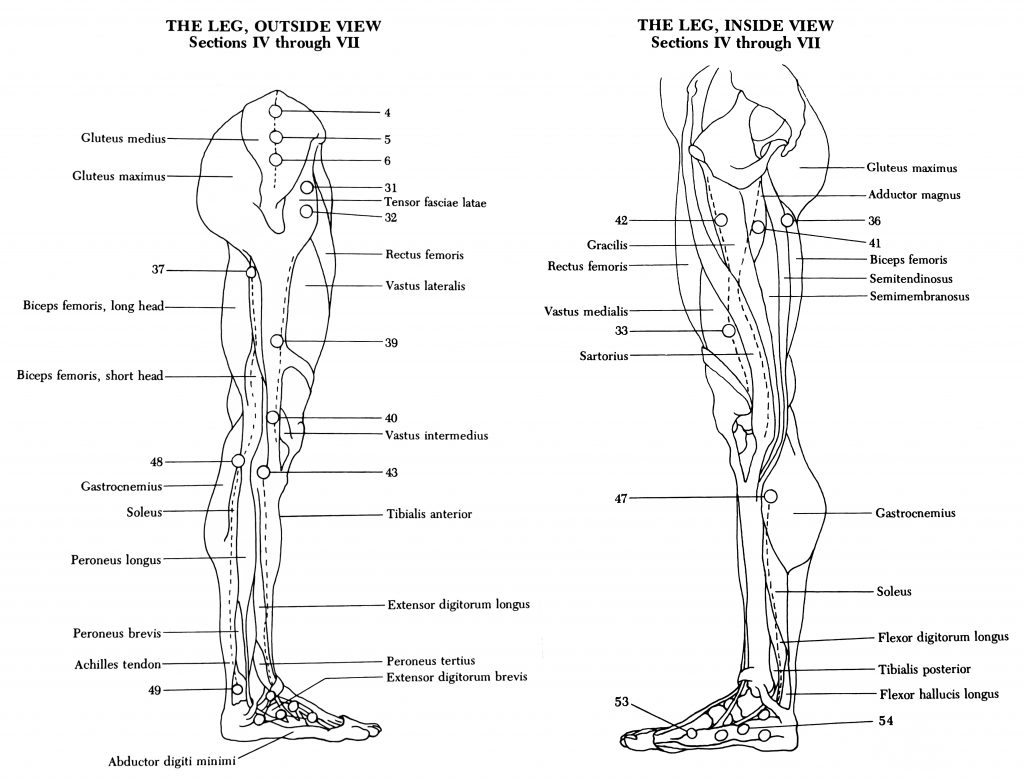IF YOUR KNEES give way as you walk or if you have pain on the outside of your knee, look to the tensor fasciae latae (TFL) and its friend the iliotibial tract (ITT). The tensor fascia is considered part of the gluteal set. It is a small but powerful muscle and its friend the iliotibial tract, a strong fibrous band, continues from it and extends to just below the outside of the knee attaching to the tibia, the larger of the two bones in the lower leg.
The purpose of the tensor fasciae latae is to create tension on the iliotibial band to keep your knees from giving way as you walk. To locate your tensor fascia stand on your left foot. Press your open right hand palm into your real or imaginary slash pants pocket. Shift your weight to your right foot and you will feel the tensor fascia tighten under the fingers and palm of your hand.
Each time you take a step the tensor fasciae contracts, giving its twin an intermittent rest. However, if you are standing still both sides contract and never get a rest. Examples of activities that aggravate the TFL and ITT are running on the road, horseback riding, and extensive periods of time in the yoga lotus position.
The cause of muscle pain is not always at the site of the pain. To address pain in the TFL or on the lateral side of the knee where the ITT ties in, look to the trigger points in the TFL. If the muscle is tight it pulls on the ITT which pulls on its attachment at the knee. Pain and or swelling at the site of the lateral knee are referred to as ITT syndrome.
Bonnie Prudden Myotherapy always addresses opposing and adjacent muscle groups so if we were to begin addressing the problems describe above we would also treat the adductor muscles, those on the inside of the leg. Think of yourself as a marionette with strings. If the muscles on the inside of the leg are tight they tend to pull toward the medial line and put strain on the outside, the hip area. To get the idea, stand on one leg and using your imagination, pull the string that will bring the other leg across in front of your body. You can then see how that might put strain on the TFL and the ITT.
Use the illustrations and follow the dotted lines to locate your trigger points. Once you’ve treated muscles they will be less tense and wondering what to do with this new sensation. This is the time you begin to reeducate them out of the tense habit and into a new habit of RELAX. Perform these exercises 4 to 8 repetitions 3 or 4 times a day. Once a day is not enough. Muscles, like children, need to be reminded often.
Finding Your Trigger Points
 If you have never experienced what a trigger point feels like, place your left arm (palm down) on a table in front of you. Make a fist with your right hand and extend the middle knuckle. Bring your knuckle down onto the top of your arm at a point just below the bend in your elbow. Press in slowly. In all probability you will feel some discomfort. Most everyone has a trigger point there because we all use our arms a lot. When you find the spot hold the pressure for 7 seconds. The “hurt” should be in the range of 5 / 6 / 7 on a scale of 1 to 10. You want to feel some discomfort but not excruciating pain. Most people describe it as a “good hurt”.
If you have never experienced what a trigger point feels like, place your left arm (palm down) on a table in front of you. Make a fist with your right hand and extend the middle knuckle. Bring your knuckle down onto the top of your arm at a point just below the bend in your elbow. Press in slowly. In all probability you will feel some discomfort. Most everyone has a trigger point there because we all use our arms a lot. When you find the spot hold the pressure for 7 seconds. The “hurt” should be in the range of 5 / 6 / 7 on a scale of 1 to 10. You want to feel some discomfort but not excruciating pain. Most people describe it as a “good hurt”.
After you have treated the trigger point you must reeducate the muscle by stretching it with what Bonnie Prudden calls corrective exercise. Extend your arm straight forward, imagining that there is a doorknob just beyond your reach. Reach forward and turn the knob clockwise as far as you can. Then rotate it counter-clockwise. Repeat 4 times to a slow rhythm.
the muscle by stretching it with what Bonnie Prudden calls corrective exercise. Extend your arm straight forward, imagining that there is a doorknob just beyond your reach. Reach forward and turn the knob clockwise as far as you can. Then rotate it counter-clockwise. Repeat 4 times to a slow rhythm.
 Basically, that is Bonnie Prudden Myotherapy®. SEARCH for the trigger point based on your muscle history, SQUASH the trigger point for 5 to 7 seconds using your knuckle, finger or elbow, then STRETCH the muscle area just treated to teach it a new habit and prevent the pain from returning.
Basically, that is Bonnie Prudden Myotherapy®. SEARCH for the trigger point based on your muscle history, SQUASH the trigger point for 5 to 7 seconds using your knuckle, finger or elbow, then STRETCH the muscle area just treated to teach it a new habit and prevent the pain from returning.
Self Help Tools
Bonnie Prudden Myotherapy® can be done with a partner or by yourself. All you need are the Self Help tools. To find these and see how to use them, go to this page on our website and click on the appropriate videos. The videos will also show you how to work on your partner.
——————————————————–
If you have questions or need help, email me at enid@bonnieprudden.com.
For more information about Bonnie Prudden®, Bonnie Prudden Myotherapy®, workshops, books, self-help tools, DVDs, educational videos, and blogs, visit www.bonnieprudden.com. Or call 520-299-8064 if you have questions or need help. Enid Whittaker, Managing Director, Bonnie Prudden Myotherapy®
